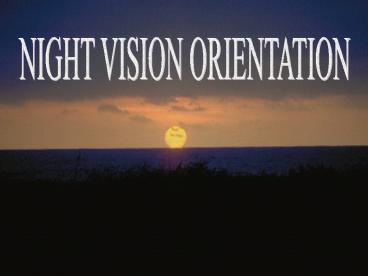NIGHT VISION ORIENTATION PowerPoint PPT Presentation
1 / 34
Title: NIGHT VISION ORIENTATION
1
NIGHT VISION ORIENTATION
2
TERMINAL LEARNING OBJECTIVE
- Action Manage the effects of visual limitations
during night flight - Condition While performing as an aircrew
member - Standard In accordance with (IAW) FM 3-04.301,
TC 1-204, FM 8-50, AR 40-501, and AR 40-8
3
PHOTORECEPTOR CELLS
- Rod cells
- Used in periods of low ambient light and darkness
- Identifies outline of shapes and silhouettes
- Poor color sense and visual acuity
- 120 million rod cells
- 101 to 10,0001ratio of rod cells to neuron cells
- Cone cells
- Used in periods of bright light
- Identifies colors
- Sharp visual acuity and color sense
- 7 million in fovea and parafovea regions
- 11 ratio of cone cells to neuron cells
4
RETINAL BLIND SPOTS
- Day blind spot
- Related to position of optic disc on the retina
- Located 15 degrees from fovea
- No Photoreceptor cells
- Encompasses 5.5 to 7.5 degrees of visual field
- Night blind spot
- Located in central viewing axis (fovea)
- Absence of rod cells in fovea
- Inability of cone cell function
- Encompasses viewing area of 5 to 10 degrees
center of visual field
5
BLIND SPOT
- Night
PERIPHERAL
PARAFOVEA
OPTIC NERVE
FOVEA
PARAFOVEA
PERIPHERAL
6
MESOPIC VISION
- Dawn, dusk, and full moonlight
- Parafoveal regions (rods and cones)
- Decreased visual acuity and color sense
7
SCOTOPIC VISION
- Night vision (partial moon and star light)
- Peripheral vision (rods only)
- Acuity degraded to silhouette recognition
- Loss of color perception
- Off center viewing (scanning)
8
DARK ADAPTATION
- 30 to 45 minutes average time period (rhodopsin)
- Duration of exposure accumulative
- May increase up to 3 to 5 hours if exposed to
glare off sand, snow, water, and direct sun - Nutrition eat a proper diet, Vitamin A
(sensitivity)
9
LIMITATIONS OF NIGHT VISION
- Depth perception (safe landings)
- Visual acuity (obstacle identification)
- Night Blind spot
- Dark adaptation (time factor)
- Color Vision
- Night myopia
- Visual Cues
10
DEPTH PERCEPTION
- False interruption or judgment of actual altitude
related to poor depth perception - Proper crew coordination
- Use searchlight or landing light if mission
permits
11
VISUAL ACUITY
20/200
20/200
20/20
20/20
12
NIGHT BLIND SPOT
You may NOT see
756
12
756
24
35
3
Crewchiefs Toolbox _at_ 30 feet
13
DARK ADAPTATION
- Exposure of bright light or solar glare effects
night vision acuity and rod cell sensitivity - Use of red lens goggles will assist dark
adaptation by reducing time requirement
14
COLOR VISION
- Photopic Mesopic
Scotopic
15
NIGHT MYOPIA
- Blue wavelength lighting causes night mypoia
- Image sharpness decreases as pupil diameter
increases - Mild refractive error factors combined, creates
unacceptably blurred vision - Focusing mechanism of the eye may move toward a
resting position (increases myopic state)
16
VISUAL ILLUSIONS
- Relative motion
- Confusion with ground lights
- False vertical and horizontal cues
- Depth Perception illusion
- Structural illusions
- Autokinetic illusion
- Size distance illusion
- Flicker vertigo
- Fascination (fixation) in flight
- Reversible perspective
- Altered planes of reference
- Crater illusion
17
VISUAL CUES
- Binocular Cues
- Monocular Cues GRAM
- Geometric perspective LAV
- Retinal image size KITO
- Aerial perspective fading colors and shades,
loss of clarity, detail, and image sharpness - Motion parallax most important cue to depth
perception
18
LASER
- LASER
- Light
- Amplification by a
- Stimulated
- Emission of
- Radiation
19
LASER
- Intense, narrow beam of light, less than 1 inch
in diameter - Widens with distance 2km-diameter is 2 meter
2Meters
2 Km
20
LASER INJURIES
- Lens Focuses and concentrates light rays
entering the eye - Concentration of energy through the lens is
intensified 100,000 times greater than the normal
light entering the eye
21
LASER INJURIES
- Amount of damage depends on laser type, exposure
time, and distance from the laser - Types of injuries
- Tiny lesions on the back of the eye
- Flash blindness
- Impaired night vision
- Severe burns effecting vast body portions
22
Hemorrhage into the vitreous
Multiple retinal laser burns
23
Corneal burns
Subretinal hemorrhage
24
LASER PROTECTIVE MEASURES
- Passive
- Take cover
- NVDS
- Squinting
- Protective goggles
- Active
- Counter measures taught or directed
- Evasive action
- Scanning with one eye or monocular optics
25
NERVE AGENTS
- Causes miosis (pupil constriction)
- Pupils will not dilate during low ambient light
- Exposure time required to cause miosis
- Depends on agent concentration and cumulative
effects of repeated exposure
26
NERVE AGENT SYMPTOMS
- Range from minimal to severe (dosage to eye?)
- Severe miosis may persist for 48 hrs
- Complete recovery may take up to 20 days
- Consult flight surgeon immediately
27
METHODS TO PROTECT NIGHT VISION
- Avoid bright lights
- Short ordnance burst
- Proper nutrition
- Avoid dehydration
- Search/landing light
- Clear visor
- Adjust dashboard, rear crew compartment, and
exterior lights - Close or cover one eye
- Supplemental oxygen
- B-LPs
- Distance from laser
28
SELF-IMPOSED STRESSES
- Drugs
- Exhaustion
- Alcohol
- Tobacco
- Hypoglycemia
29
SCANNING TECHNIQUES
- Stop-turn-stop-turn technique
- Ten degree circular overlap
- Off-center viewing
30
SCANNING
- STOP-TURN-STOP-TURN
31
(No Transcript)
32
Ten Degree Circular Overlap
10o
ETC
33
PHYSIOLOGICAL EFFECTS OF NVDS
- Depth perception
- Distance estimation is reduced
- Chromatic adaptation / discoloration of objects
- Regain dark adaptation three to five minutes
- Spatial disorientation
- A/C bank greater than 30 degrees
- Rapid scan technique
- Unfamiliar perception due to lack of NVG
experience
34
QUIZ
- Click on the link below to access the
- NIGHT VISION Quiz
- http//ang.quizstarpro.com
- Log-in and Click Search Tab
- Class Name NIGHT VISION

